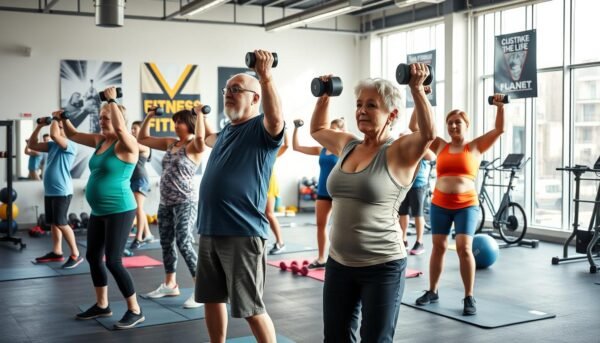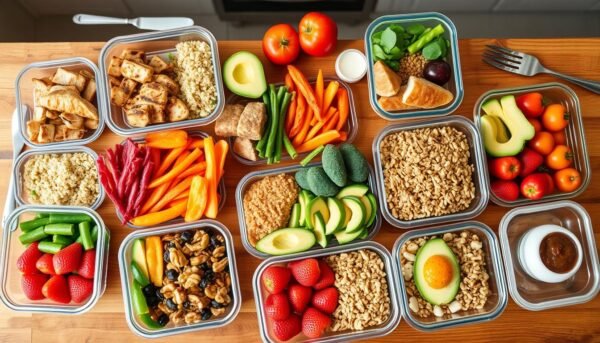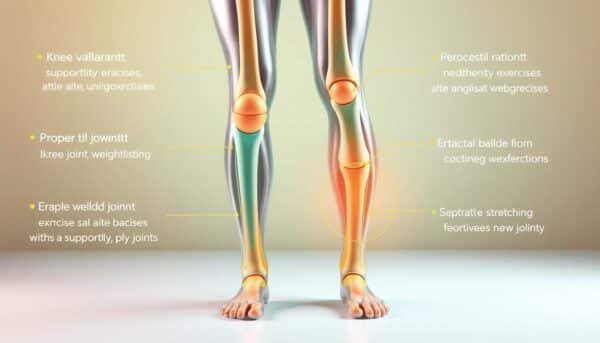As I hit my 40s, losing weight feels more urgent. I can’t just diet or jog anymore. My metabolism has slowed, and my body is harder to change. But I’m not giving up on my weight loss journey.
I’ve found that weight training is key to fat burning and calorie deficit.
I’m starting a new fitness journey and I’m excited to share my beginner workouts. These have changed my body and mind. Strength training has helped me lose weight and get toned.
It’s all about how weight training changes your body. It helps you lose fat while keeping or gaining muscle.
Let’s dive into the science of fat loss with weight training. We’ll take practical steps for success, no matter your age or fitness level. We’ll get healthier and more confident together, one weight training session at a time.
Understanding Weight Training Benefits for Weight Loss After 40

As we get older, losing weight gets harder. But, adding weight training to our workouts can change everything. It gives us a big metabolic boost and helps us transform our bodies.
Metabolic Changes in Mature Adults
After 40, we need to eat fewer calories to lose weight. Our metabolism slows down with age, making it tough to lose pounds. Weight training helps by building muscle, which burns more calories, even when we’re not moving.
Building Lean Muscle Mass
Muscles burn a lot of energy, which means they burn more calories. The more muscle we have, the more calories we burn, even when we’re resting. Weight training is great for losing fat, especially around the midsection.
Hormonal Balance and Weight Training
Keeping our hormones in balance is key for weight control as we age. Weight training helps keep our hormones right, aiding in weight loss and health. It also fights off diseases like heart disease and diabetes, and makes symptoms less severe.
Adding weight training to your routine boosts your metabolism, builds muscle, and balances hormones. These are all important for losing weight and keeping it off after 40.
| Benefit | Impact |
|---|---|
| Increased Muscle Mass | Boosts Metabolism and Calorie Burn |
| Improved Hormonal Balance | Supports Weight Loss and Overall Health |
| Reduced Chronic Disease Risk | Enhances Quality of Life |
Essential Equipment for Your Fat Loss Journey

Starting a weight loss journey is exciting and rewarding. You’ll need the right equipment to help you reach your goals. As you start exercise routines and work on portion control, a few key pieces can really help.
Dumbbells or free weights are a must for weight training. Get a set of light, medium, and heavy weights. This will let you do 12 reps of basic exercises like squats and lunges. Free weights and circuit training are great for losing fat because they work your muscles and raise your heart rate.
Resistance machines are also important. They let you focus on specific muscles and add variety to your workouts. Using both free weights and machines will help you have a balanced exercise routine.
Other key items for your journey include:
- A good fitness tracker or smartwatch to track your activity and calories
- A sturdy yoga or exercise mat for floor workouts and stretching
- Comfortable, supportive workout shoes to protect your joints
- A water bottle for staying hydrated during workouts
- A digital food scale for accurate calorie tracking and portion control
The right equipment can really help your weight loss journey. But, it’s your hard work, consistency, and a balanced diet and exercise plan that will get you there. With the right tools and a solid plan, you’ll be on your way to reaching your fitness goals.
The Science Behind Weight Training and Fat Loss

Weight training is key for losing weight. It helps build muscle, which is important for a healthy diet plan and mindful eating. Let’s explore how weight training aids in fat loss.
Muscle Mass and Metabolism Connection
Muscle burns more calories than fat, even when you’re not moving. Regular weight training increases muscle mass. This boosts your metabolism, helping you burn more calories all day.
Caloric Burn During Strength Training
Weight training makes your body burn calories. The harder and longer you work out, the more calories you burn. It’s more effective than cardio because it works your muscles harder.
Post-Exercise Oxygen Consumption
After working out, your body keeps burning calories. This is called Excess Post-Exercise Oxygen Consumption (EPOC). It can last up to 48 hours, depending on your workout.
Weight training doesn’t raise cortisol levels like cardio does. This helps you lose weight without hormonal problems. It keeps your body’s fat-burning mechanisms working well.
In short, weight training helps with fat loss by building muscle, burning calories during workouts, and keeping your metabolism up after. Adding weight training to your routine can help your body burn fat naturally. This supports your healthy diet plan and mindful eating goals.
How to lose 50 pounds Through Strategic Weight Training

Losing 50 pounds is a big goal, but it’s doable with the right plan. You need to mix weight training with a healthy diet and regular cardio. This combo will help you lose weight and change your body shape.
Begin with one day of strength training and one day of cardio each week. Then, increase this to three days of weight training and four days of cardio. Choose exercises that work many muscles at once, like squats and bench presses. Keep adding more weight or reps to keep challenging yourself.
- Addie Gibson, a TikTok influencer, lost 50 pounds in six months through a combination of weight training, walking 10,000 steps daily, and maintaining a calorie deficit.
- Strength training helps build lean muscle mass, which boosts metabolism and supports weight loss.
- Aerobic exercise, like brisk walking, can burn a significant number of calories and aid in overall fat loss.
Consistency is crucial. Stay on track, be patient, and believe in your efforts. You might see results in 4-6 weeks. But with hard work and determination, you can lose 50 pounds through strategic weight training.
Also, focus on eating fewer calories than you burn. Drink lots of water and eat snacks that are low in calories but high in volume. Try protein-enriched coffee as a meal substitute. Supplements like creatine can also help.
By combining weight training, cardio, and a balanced diet, you can unlock your body’s natural weight loss abilities. Stay consistent, be patient, and trust the process. The results will show up soon enough.
Beginner-Friendly Weight Training Schedule

Starting a fitness journey can feel scary. But, a good workout plan can help a lot. A beginner-friendly exercise routine is essential for a strong start and lasting results.
Weekly Workout Structure
Try to do three strength training sessions a week. Mix these with cardio days. Begin with full-body workouts that work many muscles at once. This method helps you build muscle and burn calories well.
Rest and Recovery Guidelines
Take 48 hours off between strength training days. This lets your muscles recover and grow. Also, have one full rest day a week. It helps your body get ready for the next workout.
Progressive Overload Principles
Use progressive overload by slowly adding more weight or reps every 1-2 weeks. This keeps your muscles challenged and supports your body transformation goals.
Here’s a sample weekly plan:
- Monday: Workout 1
- Tuesday: Cardio
- Wednesday: Workout 2
- Thursday: Cardio/Yoga
- Friday: Cardio/Yoga
- Saturday: Workout 3
- Sunday: Rest
Consistency is crucial. Stick to this exercise routine and adjust as you get stronger. With time and effort, you’ll see big changes in your body transformation.
Combining Cardio with Weight Training

Combining cardio and weight training is great for fat burning and losing weight. Many studies show it works better than doing just one. This mix can help you lose more fat than doing cardio or weight training alone.
Try to do at least 150 minutes of cardio each week. This can be walking, jogging, or cycling. You can do cardio on different days or after weight training. High-Intensity Interval Training (HIIT) is also good because it keeps burning fat even after you stop.
Cardio burns a lot of calories when you’re doing it. But weight training keeps burning calories for hours and days after. This mix can really help you lose fat.
Studies have shown the benefits of mixing cardio and strength training. For example, a 2022 study found it boosts muscle growth more than just strength training. Another 2023 study showed it increases growth hormone by 22% compared to strength training alone.
It’s important to find a balance that works for you. Try different ways, like doing cardio after weight training or using HIIT on non-lifting days. The goal is to make it fun and keep doing it.
| Cardio Recommendation | Benefits |
|---|---|
| Moderate-Intensity Cardio (150 min/week) | Accessible and approachable for most individuals |
| High-Intensity Interval Training (HIIT) | Efficient calorie burn during and after workout, increased EPOC |
Proper Form and Technique Fundamentals

Starting your exercise routine and body transformation journey? Learning the basics of proper form and technique is key. Correct movement patterns make your workouts more effective and prevent injuries.
Basic Movement Patterns
First, focus on mastering basic movements like squats, push-ups, deadlifts, and rows. These exercises work many muscles at once. They help you burn calories and build muscles evenly.
- Squats: Keep your chest up, back straight, and push down with your heels.
- Push-ups: Engage your core, keep elbows in, and lower your chest slowly.
- Deadlifts: Bend at the hips, keep your back flat, and hold the bar with your shoulders back.
- Rows: Pull your shoulder blades back, keep your core tight, and pull the weight to your chest.
Common Exercise Mistakes to Avoid
When doing these exercises, watch out for common mistakes. Avoid using momentum, not engaging your core, and bad breathing.
- Momentum-driven Movements: Use your muscles to lift the weight, not just momentum.
- Lack of Core Engagement: Stabilize your spine and transfer force by keeping your core tight.
- Improper Breathing: Breathe out when you exert and in when you release to keep your core stable.
Start with bodyweight exercises to get your form right before adding weights. Working with a certified trainer can help. Listen to your body to know if you’re doing it right.
Nutrition Strategies to Support Weight Training

Starting your weight training journey for fat loss? It’s important to match your workouts with a healthy diet. Eating mindfully helps with muscle growth, recovery, and overall health. Here are some key nutrition tips:
- Make sure you eat enough protein. Aim for 0.73 grams of protein per pound of body weight. Choose lean proteins like chicken, fish, eggs, and plant-based options like beans, lentils, and tofu.
- Eat whole, nutrient-rich foods. Swap refined carbs for complex carbs from fruits, veggies, and whole grains. Add healthy fats from avocados, nuts, seeds, and olive oil.
- Drink plenty of water. Stay hydrated, especially before and after workouts. Water helps muscles work better and recover faster.
- Eat a protein-rich snack or meal within 30 minutes of working out. This helps muscles recover and replenishes energy.
- Stay away from processed and fast foods. They have added sugars, unhealthy fats, and sodium that can hurt your weight loss goals. Try to eat whole, minimally processed foods as much as you can.
By following these nutrition tips, you’ll support your weight training goals and lose fat in a healthy way. Remember, being consistent and balanced is key to lasting success.
Safety Considerations for Over 40 Athletes

Starting our weight loss journey and body transformation is exciting. But, we must think about our joint health and safety. Our bodies change in our 40s and beyond, needing extra care in our workouts.
Joint Protection Methods
Proper warm-ups and cool-downs are key for joint safety. Doing exercises that improve mobility and flexibility is also important. Using weight belts or knee sleeves can offer extra support and protection.
Begin with lighter weights and focus on form. Then, slowly increase the workout intensity. This way, we build strength and muscle safely.
Pre-workout Assessment
Do a pre-workout check before starting. Try exercises like hanging, planks, or bodyweight squats. If these are hard, work on basic movements first.
Talking to a healthcare provider is smart. They can spot any health issues that might affect our workouts. Their advice helps us start our fitness journey safely.
| Joint Protection Strategies | Pre-workout Assessment |
|---|---|
|
|
By following these safety steps and doing a pre-workout check, we can start our weight loss journey and body transformation safely. This way, we avoid injuries and make steady progress.
Tracking Progress and Making Adjustments
On your weight loss journey and body transformation quest, it’s key to track your progress often. This keeps you motivated and lets you tweak your plan as needed.
Begin by measuring your body, like your waist, hips, and thighs. These measurements give a clearer view of your progress than just the scale. Also, take progress photos every 4-6 weeks to see your changes.
Keep a workout log to see your strength growth. Write down the weights, reps, and sets for each exercise. This shows where you’re getting better and keeps you challenged.
| Measurement | Initial | 4 Weeks | 8 Weeks | 12 Weeks |
|---|---|---|---|---|
| Waist | 36 inches | 34 inches | 32 inches | 30 inches |
| Hips | 42 inches | 40 inches | 38 inches | 36 inches |
| Thighs | 24 inches | 22 inches | 20 inches | 18 inches |
The scale might not always show your progress right, especially when you gain muscle. Instead, pay attention to how your clothes fit and how you feel.
Every 4-6 weeks, check your progress and adjust your plan. You might need to lift heavier, change your rep ranges, or try new exercises. Stay patient and keep going, as big changes take time.
Tracking your progress and making changes keeps you motivated. It makes sure your weight loss journey and body transformation are on track. Celebrate every small win and keep moving forward.
Building a Sustainable Long-term Routine
Starting your weight loss journey means creating a routine you can keep up. Choose exercises you like, like weight training or brisk walks. Start slowly and increase your efforts to keep making progress.
It’s also key to mix up your workouts. This keeps things interesting and prevents boredom. Try different exercises and balance them with activities like yoga or sports.
Don’t forget about your lifestyle. Get enough sleep, manage stress, and eat well. These habits help your body lose weight and stay healthy. Stay true to your plan and celebrate your successes.
This post may contain affiliate links which means I may receive a commission for purchases made through links. I will only recommend products that I have personally used! Learn more on my Private Policy page.